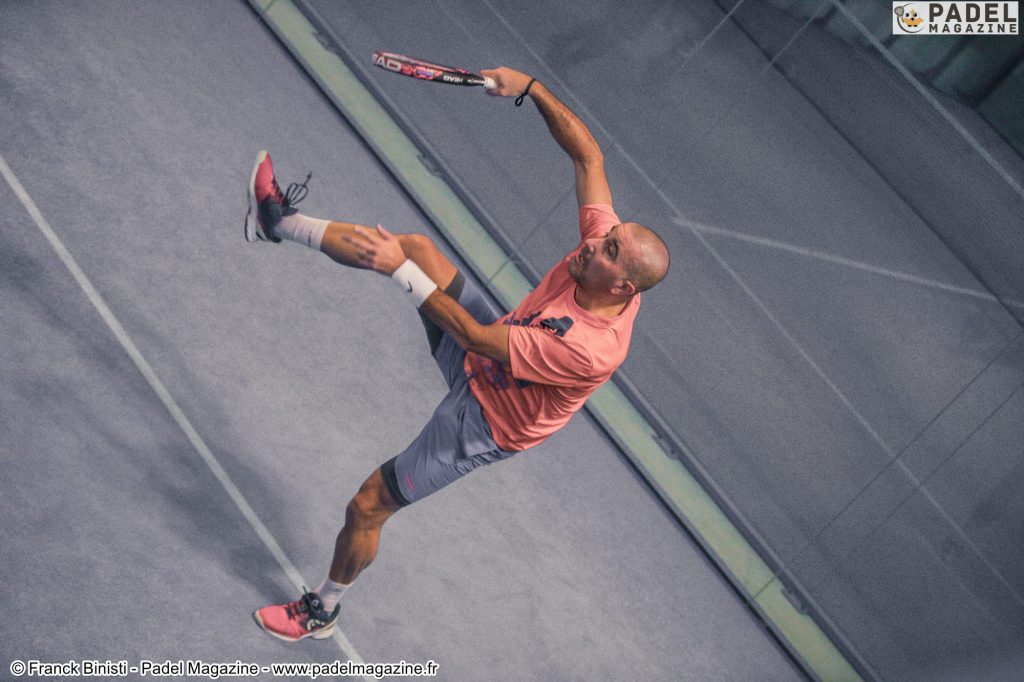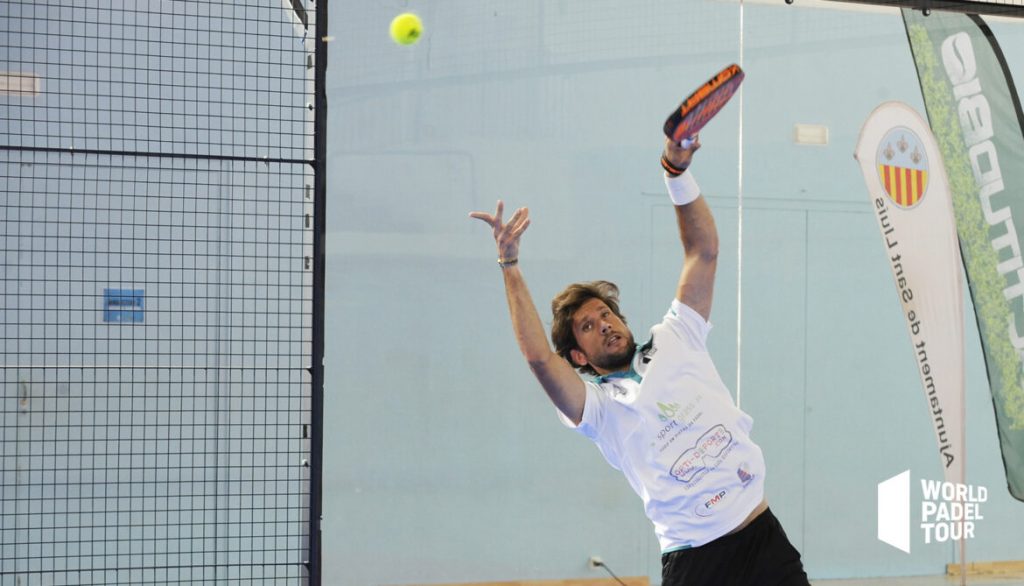Use Grid can become the key to get out of a match that seemed hopeless. How to play it et how to defend it ? We guide you.
Have you ever tried to play the grid? From the back or from the net, when we attack, playing the grid is quite attractive and impressive at the same time because we don't know what will happen next. When we defend it's exactly the same reaction; the fear of losing the point due to a rebound, or the fear of leaving pieces of carbon from your pala on the road…
When to play the grid?
This is the first question to ask. First you will be able to find the grid which is in your diagonal more easily than the grid which is on your side. Then the more angle you have the easier it will be, and finally, the more time you have, the more angle you will have.
So let's take as an example a right-hander posted on the left at the back of the track. When will he be able to play the grid? Directly in the forehand it will be very difficult because it is unnatural. Backhand perhaps because the angle will allow you to get this short cross zone. Those with a two-handed backhand should have an easier time lifting the ball with their wrists. For a one-handed backhand, it will be better to wait for a slower ball with more bounce, which will allow you to better adjust your attack to the grid.
Coming out of the window, we will have a problem on the reverse side knowing that the grid will be behind us. The only solution: the ball which will bounce at the level of our left shoulder and which will give us the angle and the sufficient height to lodge the ball at the grid. This shot is very difficult, but so spectacular… On the forehand side, it's much simpler because even with a medium rebound you can hit with enough time to work with your wrist and find the best speed and the best angle.
On the fly, finding the grid will be easier when you have the possibility of impacting the ball above the net. Forehand or backhand cross volleys, the important thing is to hit the ball well in front of you to create an angle. For a right-handed person, the bandeja or víbora will be good opportunities, when you have to play them close to your own grid, to find the opposite grid in your diagonal. For left-handers or right-handers posted on the left, finding the grid will be done with the “rulo” or the slow smash also from a position close to your grid or window for always the same reason: the angle.

How to play the grid?
You can play the grid with several effects: cut during volleys or exits from high windows, lifted during balls from the bottom of the track or for “rulos”, flat when exiting from low windows and brushed during víboras. The rebounds will all be different depending on the effect of course but above all depending on the area of the grid affected, and that is impossible to define. On the other hand, we can say that depending on the speed, the ball will be easier to play or not for the opponents.
By testing on the track we discovered that at low speed, out of 10 balls played to the grid, the defender and his partner saved 8 which is huge. On the other hand, as soon as the ball hit the grid at high speed, the curve was reversed with only 3 balls saved by the defenders. So the faster it is, the harder it is to defend.
How to defend the grid?
The first thing to say is that the grid is defended by two because depending on the rebound it may be up to your partner to recover the ball. Then you have to let the ball bounce with the pala placed down, ready to impact. If you run towards the gate, you risk damaging your pala. So for low balls, pala down, and without rushing, you let it bounce.
For higher balls like grids after a smash that has bounced off the back glass and is coming towards the net, it will be much more difficult. Try to find yourself behind the ball, and when it hits the grid, wait for it above your belt and then…let luck do the talking. Finally, during the “rulos” one of the techniques consists in preventing the ball from touching the grid and therefore taking it directly. But in the event that it comes into contact with the metal, your partner should be ready to defend.
Conclusion
Playing the grid or knowing how to defend the grid can help you tip the match on your side. You have been attacking towards the back panes so far and lost the first set, now the gates take the lead in the second set. Sometimes, in defense, you have all the rebounds in your favor and bring back all the balls, which makes your opponents trip!
The grids are therefore a good way to bring chance and good fortune into play. padel. Use them wisely and don't hesitate to congratulate your opponents if you can't defend, this will save you unnecessary irritation! Let's go!
Julien Bondia is a teacher of padel in Tenerife (Spain). Columnist and advisor, he helps you play better through his tutorials and tactical/technical articles padel.





































































































 Premier Padel Brussels P2 – The women’s Big 4 at the semi-finals!
Premier Padel Brussels P2 – The women’s Big 4 at the semi-finals! Premier Padel Brussels P2 – Sanz and Nieto win a big fight against Lebron / Navarro!
Premier Padel Brussels P2 – Sanz and Nieto win a big fight against Lebron / Navarro! Premier Padel Brussels P2 – The break obviously did Sanchez / Josemaria good!
Premier Padel Brussels P2 – The break obviously did Sanchez / Josemaria good! Premier Padel Sevilla P2 – From the waiting list to previas for Dylan Guichard and Ricardo Martinez!
Premier Padel Sevilla P2 – From the waiting list to previas for Dylan Guichard and Ricardo Martinez! Guillaume Codron de Sud Padel : “A family project”
Guillaume Codron de Sud Padel : “A family project” Nallé Grinda: “Democratize the padel in the USA with PadelX "
Nallé Grinda: “Democratize the padel in the USA with PadelX " Simon Boissé: “We know that there are two nations in front of us”
Simon Boissé: “We know that there are two nations in front of us” Marie Maligo: “This period of frequent changes of partners was beneficial for me”
Marie Maligo: “This period of frequent changes of partners was beneficial for me” Gilles Moretton: “We will be able to put the padel at the level of tennis”
Gilles Moretton: “We will be able to put the padel at the level of tennis” Two P1000 doubled prize money approaching!
Two P1000 doubled prize money approaching! José Manuel Escin at the inauguration of Casa Padel DOS: “Finally, and thank you!”
José Manuel Escin at the inauguration of Casa Padel DOS: “Finally, and thank you!” Miguel Lamperti: three tie-breaks and a return to the quarter-finals!
Miguel Lamperti: three tie-breaks and a return to the quarter-finals! Big evening in Brussels with two seeded players on the mat, heckled number 1s…
Big evening in Brussels with two seeded players on the mat, heckled number 1s… A1 Padel – the French Open replaces the Mexican Open on the calendar
A1 Padel – the French Open replaces the Mexican Open on the calendar Padel Score comes to Tahiti for American Express Padel Cup!
Padel Score comes to Tahiti for American Express Padel Cup! Do you know the Rafa Nadal Academy Tour?
Do you know the Rafa Nadal Academy Tour? Play at padel on his yacht? Possible for €233.000!
Play at padel on his yacht? Possible for €233.000! Our Top 10 training courses padel in France and Europe
Our Top 10 training courses padel in France and Europe At the heart of padel – Episode 25: Paul and Andoni answer your questions
At the heart of padel – Episode 25: Paul and Andoni answer your questions Tactical padel – What to do when faced with players who systematically stay at the bottom?
Tactical padel – What to do when faced with players who systematically stay at the bottom? The basic tactics of padel
The basic tactics of padel At the heart of padel – Episode 25: Paul and Andoni answer your questions
At the heart of padel – Episode 25: Paul and Andoni answer your questions At the heart of padel – Episode 23: defend the window well
At the heart of padel – Episode 23: defend the window well Prohibition on playing topless Padel : the reasons
Prohibition on playing topless Padel : the reasons FIP Tour – Going far from Europe, THE strategy to earn points!
FIP Tour – Going far from Europe, THE strategy to earn points! What is a good football player? padel ?
What is a good football player? padel ? “Lefties give me headaches when I play against them!”
“Lefties give me headaches when I play against them!” At the heart of padel – Episode 14: how to earn points in winter?
At the heart of padel – Episode 14: how to earn points in winter? A par 4 is always a winner...even if you manage to defend it!
A par 4 is always a winner...even if you manage to defend it! Carbon fiber VS fiberglass: what to choose?
Carbon fiber VS fiberglass: what to choose? How to effectively test a racket padel ?
How to effectively test a racket padel ? La padel to fight Parkinson's disease
La padel to fight Parkinson's disease Don't play with a cracked or broken racket, your body will thank you!
Don't play with a cracked or broken racket, your body will thank you! Michel Cymes: “The padel, physically, it’s serious!”
Michel Cymes: “The padel, physically, it’s serious!” Jeremy Gala: “Promote the padel among young people in Belgium remains a challenge”
Jeremy Gala: “Promote the padel among young people in Belgium remains a challenge” The French Touch Academy organizes its selection day Padel-Study
The French Touch Academy organizes its selection day Padel-Study Report on the detection and training of younger generations
Report on the detection and training of younger generations